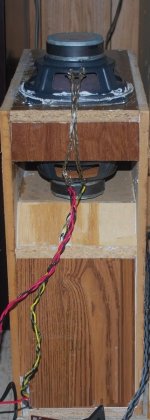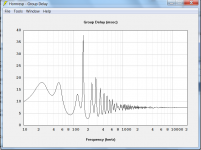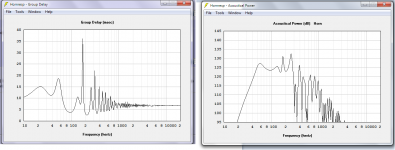I mean that kind of compund
http://bilder.hifi-forum.de/medium/665915/neu-bitmap_401827.jpg
http://www.lavalu.de/images/compound.gif
http://bilder.hifi-forum.de/medium/665915/neu-bitmap_401827.jpg
http://www.lavalu.de/images/compound.gif
I can see a straight flare TH being useful in an isobaric arrangement.
I tried something different. Not isobaric, was a push-push.
I build original Martinson 6,5 TH, tested with single driver - works great, nice tone and tactile fillings.
Then, before to trow away those ugly boxes push-pull, and latest was a push-push and it works the best. Deep, fast, nice tactile fillings. Actually it could be compare to two same size TH with one driver.
Attachments
Hrmupf!...I build original Martinson 6,5 TH, tested with single driver - works great, nice tone and tactile fillings.
Then, before to trow away those ugly boxes
Sure, blame the inocent looking designer why don't you, it's not his fault the laws of physics exhanged glances with a tight budget at a party, I only tried to raise the bastard well enough that's all
Wow! Any measurements versus simulation?
Unfortunately not measurement.
But it was unexpected have so mush bass coming from such compact enclosure.
Thanks to Martinsson!
So here we go, this is the THAM15 tapped horn :

Yes, I'm resurrecting a 5-year old thread, but there's a reason
For those of you who built the original THAM15, are you interested in trying a tweak to it? See the following link for an idea of what this tweak is, and the possible effect it can have on TH's like the THAM15 that feature a notch in the response curve.
http://www.diyaudio.com/forums/subwoofers/276742-cone-compensation-test-case-12.html#post4385245
44.72V and the impulse is posted. I would appreciate your interpretation of the impulse as I have not made a clear opinion of my own regarding GD... I would guess 10ms but this is based on a combination of some manual calcs of path length I've made in the past and also looks like an average of the impulse under 100Hz.
Attachments
44.72V and the impulse is posted. I would appreciate your interpretation of the impulse as I have not made a clear opinion of my own regarding GD... I would guess 10ms but this is based on a combination of some manual calcs of path length I've made in the past and also looks like an average of the impulse under 100Hz.
I'd start with 7.5ms.
if you have that already modeled could you post an spl graph of that too so I can save it for the collection (thanks for saving me the time on the impulse!)
44.72V and the impulse is posted. I would appreciate your interpretation of the impulse as I have not made a clear opinion of my own regarding GD... I would guess 10ms but this is based on a combination of some manual calcs of path length I've made in the past and also looks like an average of the impulse under 100Hz.
Brian, could you please elaborate? Also, you are using the THAM15 for your experiment right? What driver? THANKS
Re delay, look at value the GD graph takes near the right hand side. I found that's usually a good place to start re delay as it appears to be representative of the path length in ms.
I'm not using the THAM15. I noticed the original sim for the THAM15 didn't include any cone compensation, and adding the volume of air in front of the cone to the sim results in an even deeper dip above the passband. So, adding cone compensation at S2 (which will bring the built TH back in line with the sim) should reduce the dip.
Vax, I made a little mistake. I had different versions of the THAM15 saved under the same name in HR. In any event, you can use 50V (325w) with the 4015LF in the original THAM15 design. You are correct about the voltage is determined by xmax. HR export, revised GD image, and SPL image attached.
Thanks Brian. Looks forward to reading your results.
Thanks Brian. Looks forward to reading your results.
Attachments
Vax, I made a little mistake. I had different versions of the THAM15 saved under the same name in HR. In any event, you can use 50V (325w) with the 4015LF in the original THAM15 design. You are correct about the voltage is determined by xmax. HR export, revised GD image, and SPL image attached. .
That FR graph suggests that the dimensions of the THAM for that driver might need a bit of adjustment to flatten out the response. There is likely going to be a slight droop in the upper end of the response (based on my tests with a similar layout), so you don't want to start off with a sim that suggests that there's going to be a peak at the low end of the passband.
- Home
- Loudspeakers
- Subwoofers
- THAM15 - a compact 15" tapped horn


